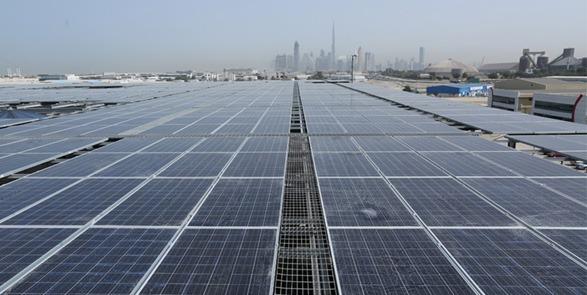
Never mind the social strife and political stability that has long been widespread across the Middle East. Many countries across the MENA (Middle East/North Africa) region are notorious for having painfully slow bureaucracies, as well as suffering from epic corruption and a lack of transparency. Add low oil prices and their impact on national budgets, and one would wonder why anyone in the clean-energy sector would want to do business in this region.
But despite the challenging economic and political environment, renewables -- especially solar power technologies -- are enjoying a surge, from the Mediterranean shores of North Africa to the posh cities within the oil-rich Gulf nations. Add Iran, which is slowly becoming more integrated in the global economy as more sanctions are lifted, therefore sparking the interest of overseas investors seeking to harvest its abundant sunshine.
Of course, just because the skies are often clear does not mean solar is a no-brainer. First, the sandy dust endemic in the region can coat solar panels and reduce their efficiency on the best days; the fierce winds that can blow from the Arabian Peninsula can also knock them out of service. The Middle East’s scorching heat can actually reduce solar cells’ performance as well. Furthermore, the lack of skilled workers in the region, compared to North America and Europe, also affects the speed with which renewables can scale throughout the Middle East.
But in countries lacking energy resources, such as Egypt and Jordan, clean energy is a way to keep the lights on and reduce the need for expensive imported fossil fuels such as diesel. Nations abundant in oil, such as Saudi Arabia, Qatar and the United Arab Emirates, have an opportunity to diversify their economies and, pragmatically, sell petroleum to countries abroad instead of squandering it on subsidized energy at home.
So as these nations try to transform their economies and adjust to 21st-century realities, renewables have garnered more interest from government officials at home and investors abroad.
In the UAE, while Abu Dhabi scores plenty of attention due to its investment in Masdar, nearby Dubai is holding its own with massive investments in solar power. The emirate’s Dubai Energy and Water Authority (DEWA), for example, has announced that it received a record-low bid of $2.99 per kilowatt hour for the third phase of a huge solar park. Originally targeted to generate 1 gigawatt of power, DEWA now plans for this facility to produce 5 GW of clean power annually by 2030. Dubai World, which operates the city’s ports, is also on a solar binge, with a huge rooftop solar project in the Jebel Ali district that could add up to 40 GW of solar power to the local grid by the end of this year.
For Dubai, investment in renewables makes sense. The city of 2.5 million has arguably become the Middle East’s leading business center in the wake of the Arab Spring. Nevertheless, the emirate has few oil reserves (Abu Dhabi has 94 percent of the UAE’s oil), and the city’s unwieldy real estate market has become an expensive place in which to conduct business.
For the poorer Middle Eastern states, solar and wind power present a tactic to shield citizens from volatile energy prices. In Jordan, the government welcomed investors to build solar installations across the country, largely through a feed-in tariff program. Fossil fuel imports, reports The Economist, generate 96 percent of Jordan's energy at a cost of 10 percent of the nation’s GDP. To the southwest, Egypt has received generous foreign aid from the UAE in the form of new solar installations that have appeared across the country. Meanwhile, an international consortium led by Terra Sola is undertaking projects that will add 2 GW of solar power in the Arab world’s most populous country.
Even Iran, which has a reputation for providing its citizens with some of the most generous subsidies on Earth, is looking to solar as it implements reforms. German investors have shown interest in developing the country’s tiny renewables sector, and news reports suggest that Italian companies are behind a plan to install 1 GW of solar power over the next decade.
For many Middle Eastern countries, the windfalls enjoyed from oil and natural gas have sometimes been a blessing, but often a curse. But despite the fall in oil prices, the combination of cheap solar power, lower operational costs and political will present new opportunities for these nations to expand energy access, diversify their economies and provide new careers for their citizens. And considering many of these nations have the most rapidly growing populations in the world, renewables are a path toward energy security and, therefore, domestic security.
Image credit: DEWA

Leon Kaye has written for 3p since 2010 and become executive editor in 2018. His previous work includes writing for the Guardian as well as other online and print publications. In addition, he's worked in sales executive roles within technology and financial research companies, as well as for a public relations firm, for which he consulted with one of the globe’s leading sustainability initiatives. Currently living in Central California, he’s traveled to 70-plus countries and has lived and worked in South Korea, the United Arab Emirates and Uruguay.
Leon’s an alum of Fresno State, the University of Maryland, Baltimore County and the University of Southern California's Marshall Business School. He enjoys traveling abroad as well as exploring California’s Central Coast and the Sierra Nevadas.














